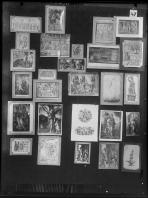Among the many intertwined narratives that emerge from the “last version” of Warburg’s atlas, the simplest is a linear history of European art following a traditional periodization. After an overture on Antiquity (Panels 1-8) and the Middle Ages (20-24), its core addresses the Renaissance and the Baroque (25-76), followed by a coda on mass media and spectacle (77-79).
Within this framework, Panel 47 is the penultimate element of a coherent sequence on the Florentine art of the later fifteenth century. Warburg’s image of this period is dominated by the works of Domenico Ghirlandaio. Panel 43, which opens the sequence, focuses on Ghirlandaio’s paintings for the chapel of the Sassetti family in the church of Santa Trinità. Many of the images in this and the following panels had already appeared in Warburg’s two seminal essays on the chapel and its patron, the banker Francesco Sassetti.
Those essays’ concerns are reflected in the captions of the first and last panels in the series. 43: “Sassetti —Ghirlandaio as an exponent of bourgeois culture. Intrusion of the portrait — sense of self....” 48: “Fortuna. Symbolic distillation of man’s struggle to free himself (merchant).” Heralded in Jacob Burckhardt’s Civilization of the Renaissance in Italy (1860), by the early twentieth century these were familiar themes in German-language cultural history: the simultaneous and interconnected emergence of a proto-capitalist economy and an individual consciousness among the bankers, merchants, and traders of the Italian city-states. They must also have possessed a more intimate resonance for Warburg, whose ancestors rose to prominence in these very milieux.
Warburg’s quattrocento was not exhausted by the “emergence of the individual,” however, and two more idiosyncratic motifs jostle for equal attention in this sequence: Siegerpathos (“the pathos of the victor”) and the ninfa (“nymph”). In Panel 44, Siegerpathos emerges from the grisaille images of ancient warriors in the Sassetti Chapel and their Roman prototypes. Typical is the relief of the Emperor Trajan depicted in full martial fury (#44.5.1), trampling barbarians with his steed, arm poised to thrust with some long lost weapon, an entire army cowering before him in fear and submission. Panel 45 turns to Ghirlandaio’s frescoes from the Cappella Maggiore of Santa Maria Novella, and “the emergence of the individual hero out of the typological grisaille.” The individual who dominates Panel 46, however, is not the warrior but the nymph, here exemplified by the figure in Ghirlandaio’s Birth of John the Baptist (#46.6) who swiftly enters the room, bearing a plate of fruit on her head. Panel 47 depicts only one work by Ghirlandaio, but it is repeated twice, and as we shall see it joins Siegerpathos and ninfa. Panel 48, finally, leaves Ghirlandaio behind to focus on the image of Fortuna in the circle of the Ruccellai, another prominent Florentine family.
